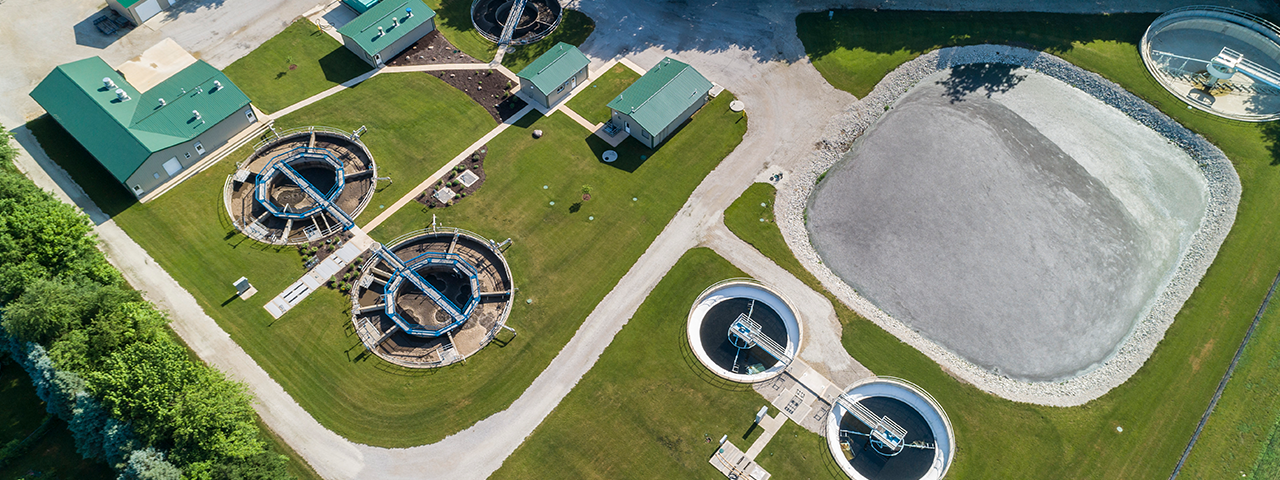Wastewater treatment plant improvements in Mahomet
MAHOMET, ILLINOIS
The Village of Mahomet, Illinois, is a growing community located in east-central Illinois. In the past decade, the population of the Village grew from 5,000 in 2007 to 8,500 in 2016. In 2008, the Village Board embarked on a project to expand its Wastewater Treatment Plant (WWTP) to meet the demands of a quickly growing population that was beginning to overload the treatment capacity of its existing facilities.
Planning for the project was completed in 2009. The new WWTP must be capable of doubling its treatment capacity to meet the expected planning year population. The new plant must remove phosphorus and nitrate nitrogen due to impairments of these contaminants in a downstream reservoir used as a potable water source for the City of Decatur, Illinois (Lake Decatur). The project also must be completed without expanding beyond the treatment plant site because there is a railroad to the north and east, a residential development to the west, and OSLAD program property to the south.
The proposed solution to these challenges included the conversion of existing twin train 0.25 Million Gallon Conventional Activated Sludge (CAS) package plant reactors to a Biological Nutrient Removal (BNR) facility. By applying Integrated Fixed film Activated Sludge (IFAS) technology to the aerobic reactors, the efficiency of those reactors was increased by 300%, allowing the requisite aerobic tank volume to be decreased by 1/3 over what would have been possible with CAS. The reduction in aerobic tank volume allowed the remaining tank volume to be converted into anaerobic and anoxic tank volume to support the removal of phosphorus and nitrate nitrogen.
The treatment capacity was doubled and nutrient removal was accomplished without the construction of additional reactor volume. Also, the new BNR-IFAS facility was designed so that when additional capacity is needed, the Village need only add IFAS media to the aerobic reactors to provide an additional 40% capacity.
The BNR-IFAS facility can operate in multiple configurations to address changes to the characteristics of the influent flow and operational methods of the WWTP over its service life. The BNR-IFAS facility also can operate in A2O, MLE, UCT, MUCT, and VIP process configurations as determined to be the most beneficial by the WWTP operator. Additional improvements included 1/4-inch screening equipment, secondary clarifiers, refurbished tertiary filters, new aerobic digesters, and chemical feed facilities.
Our team also assisted the Village in securing a renewed NPDES permit for the expanded plant and prepared the CMOM planning report in compliance with the CMOM special conditions.
Planning for the project was completed in 2009. The new WWTP must be capable of doubling its treatment capacity to meet the expected planning year population. The new plant must remove phosphorus and nitrate nitrogen due to impairments of these contaminants in a downstream reservoir used as a potable water source for the City of Decatur, Illinois (Lake Decatur). The project also must be completed without expanding beyond the treatment plant site because there is a railroad to the north and east, a residential development to the west, and OSLAD program property to the south.
The proposed solution to these challenges included the conversion of existing twin train 0.25 Million Gallon Conventional Activated Sludge (CAS) package plant reactors to a Biological Nutrient Removal (BNR) facility. By applying Integrated Fixed film Activated Sludge (IFAS) technology to the aerobic reactors, the efficiency of those reactors was increased by 300%, allowing the requisite aerobic tank volume to be decreased by 1/3 over what would have been possible with CAS. The reduction in aerobic tank volume allowed the remaining tank volume to be converted into anaerobic and anoxic tank volume to support the removal of phosphorus and nitrate nitrogen.
The treatment capacity was doubled and nutrient removal was accomplished without the construction of additional reactor volume. Also, the new BNR-IFAS facility was designed so that when additional capacity is needed, the Village need only add IFAS media to the aerobic reactors to provide an additional 40% capacity.
The BNR-IFAS facility can operate in multiple configurations to address changes to the characteristics of the influent flow and operational methods of the WWTP over its service life. The BNR-IFAS facility also can operate in A2O, MLE, UCT, MUCT, and VIP process configurations as determined to be the most beneficial by the WWTP operator. Additional improvements included 1/4-inch screening equipment, secondary clarifiers, refurbished tertiary filters, new aerobic digesters, and chemical feed facilities.
Our team also assisted the Village in securing a renewed NPDES permit for the expanded plant and prepared the CMOM planning report in compliance with the CMOM special conditions.
AT A GLANCE
» Topographic survey.
» Funding assistance.
» Contract documents for funding sources.
» Engineering design.
» Plans and specifications preparation.
» Permitting.
» Bid letting.
» Construction staking, observation and administration.


